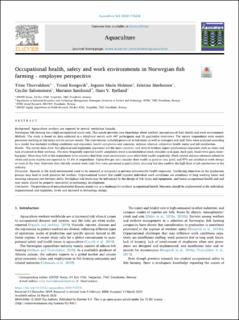| dc.contributor.author | Thorvaldsen, Trine | |
| dc.contributor.author | Kongsvik, Trond | |
| dc.contributor.author | Holmen, Ingunn Marie | |
| dc.contributor.author | Størkersen, Kristine Vedal | |
| dc.contributor.author | Salomonsen, Cecilie | |
| dc.contributor.author | Sandsund, Mariann | |
| dc.contributor.author | Bjelland, Hans Vanhauwaert | |
| dc.date.accessioned | 2020-07-13T08:35:44Z | |
| dc.date.available | 2020-07-13T08:35:44Z | |
| dc.date.created | 2020-03-18T13:38:10Z | |
| dc.date.issued | 2020 | |
| dc.identifier.citation | Aquaculture. 2020, 524 | en_US |
| dc.identifier.issn | 0044-8486 | |
| dc.identifier.uri | https://hdl.handle.net/11250/2663870 | |
| dc.description.abstract | Background Aquaculture workers are exposed to several workplace hazards. Norwegian fish farming has a high occupational injury rate. This article provides new knowledge about workers' perceptions of their health and work environment. Methods The study is based on data collected in a telephone survey with 447 participants and 35 qualitative interviews. The survey respondents were mainly personnel working at fish farms and on service vessels. The interviewees included personnel at fish farms as well as managers and staff. Data were analysed according to a model that included working conditions and exposures, health complaints and concerns, sickness absence, subjective health status and job satisfaction. Results The survey data show that physical and ergonomic exposures are the most common, and several workers report psychosocial exposures such as stress and lack of control in their workday. The most frequently reported health complaints were musculoskeletal (neck/shoulder/arm pain, back pain, hand/wrist pain, knee/hip pain). More than half of the respondents have concerns that their work environment may affect their health negatively. Work-related sickness absences related to strain and acute injuries are reported by 11.6% of respondents. Eighty-five per cent consider their health as good or very good, and 97% are satisfied at work always or most of the time. Interview data identify several work tasks that were perceived as particularly straining but also confirm the high level of job satisfaction in the industry. Discussion Hazards in the work environment need to be removed or mitigated to prevent unfavourable health exposures. Conflicting objectives in the production process may lead to work pressure for workers. Organisational factors that could improve individual work conditions are avoidance of long working hours and ensuring adequate rest between shifts. Workplace risk levels may be influenced by the design of fish farms and equipment, and hence occupational health and end user needs should be properly considered in technology development. Conclusion The prevalence of musculoskeletal diseases stands out as a challenge for workers' occupational health. Measures should be implemented at the individual, organisational and regulatory levels and included in technology design. | en_US |
| dc.language.iso | eng | en_US |
| dc.publisher | Elsevier | en_US |
| dc.rights | Navngivelse 4.0 Internasjonal | * |
| dc.rights.uri | http://creativecommons.org/licenses/by/4.0/deed.no | * |
| dc.title | Occupational health, safety and work environments in Norwegian fish farming - employee perspective | en_US |
| dc.type | Peer reviewed | en_US |
| dc.type | Journal article | en_US |
| dc.description.version | publishedVersion | en_US |
| dc.source.volume | 524 | en_US |
| dc.source.journal | Aquaculture | en_US |
| dc.identifier.doi | 10.1016/j.aquaculture.2020.735238 | |
| dc.identifier.cristin | 1802235 | |
| dc.description.localcode | This is an open access article distributed under the terms of the Creative Commons CC-BY license, which permits unrestricted use, distribution, and reproduction in any medium, provided the original work is properly cited. | en_US |
| cristin.ispublished | true | |
| cristin.fulltext | original | |
| cristin.qualitycode | 1 | |

